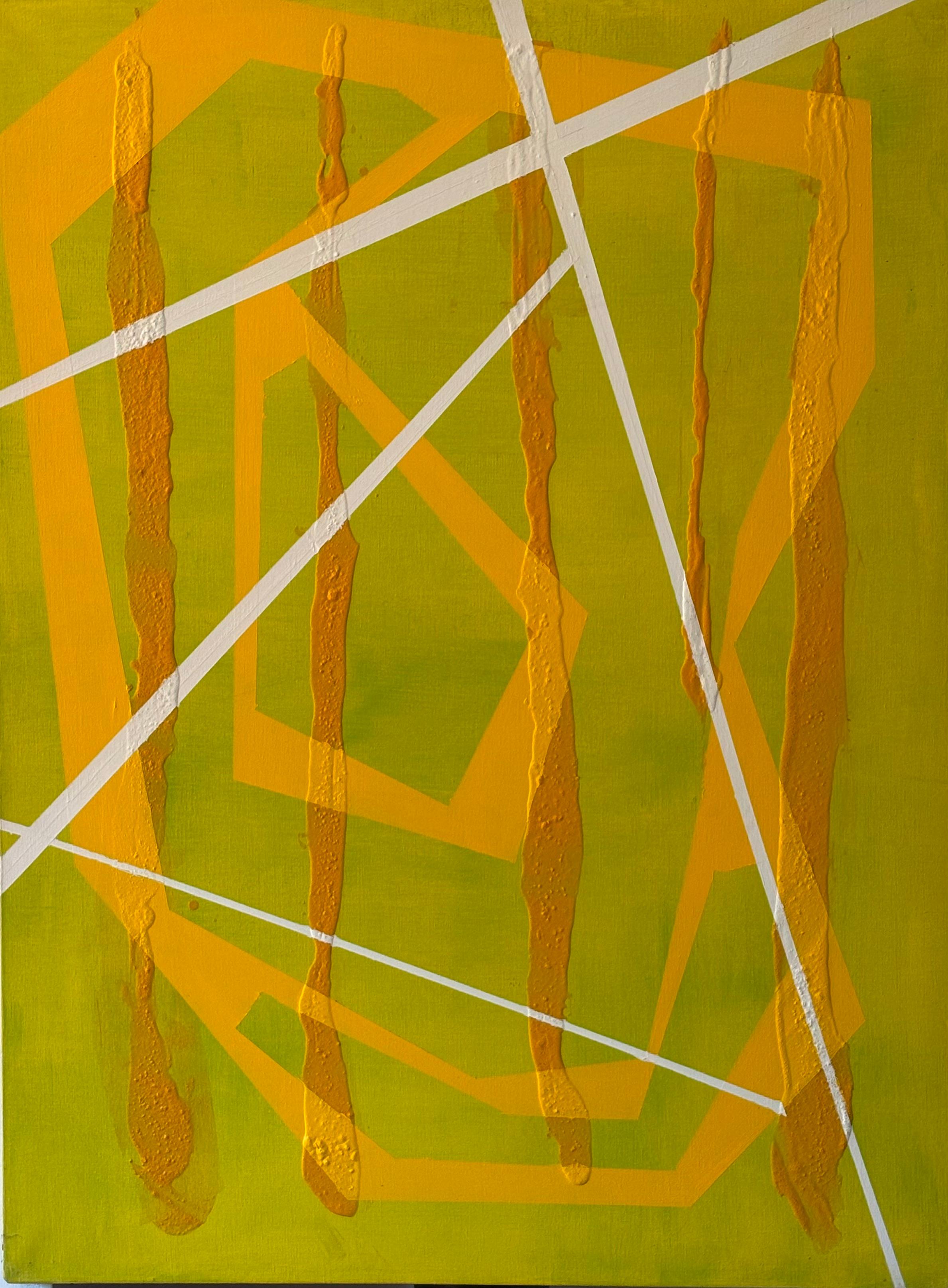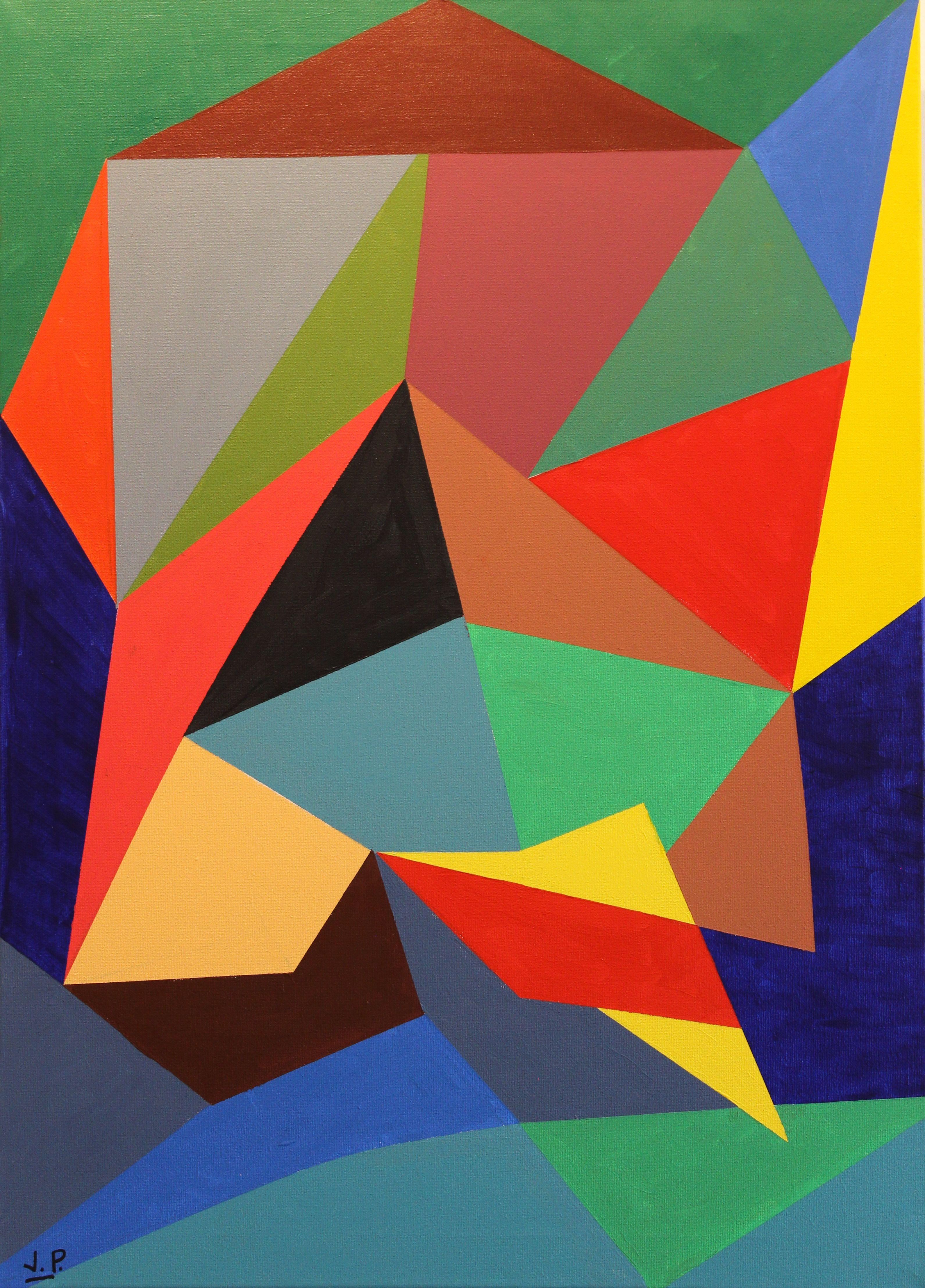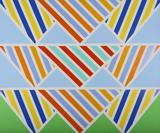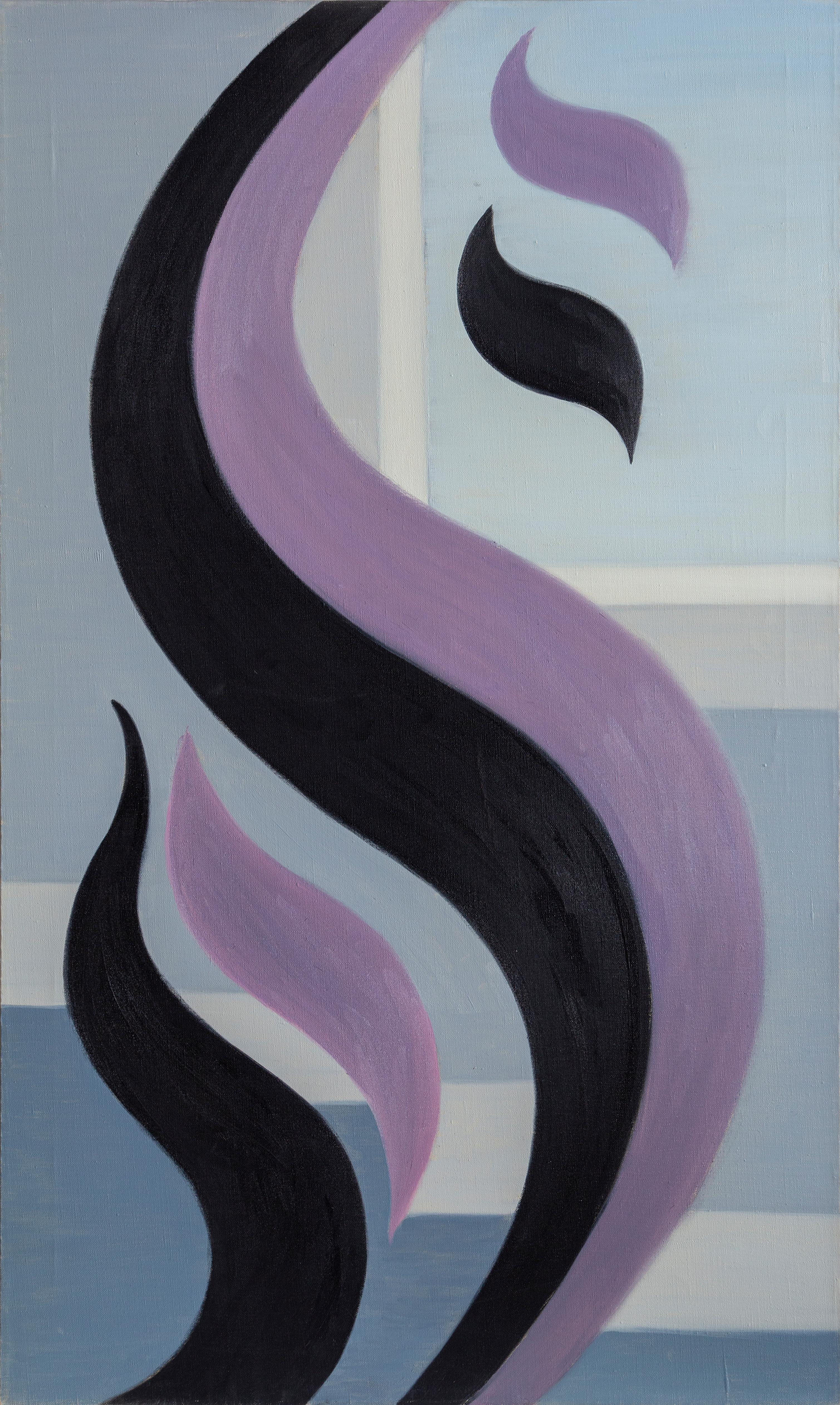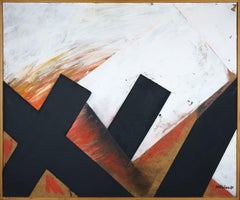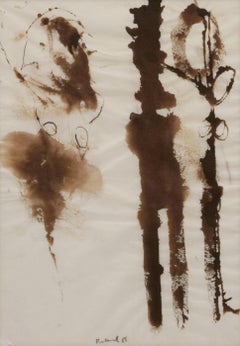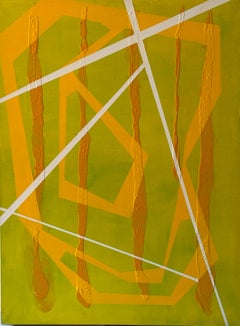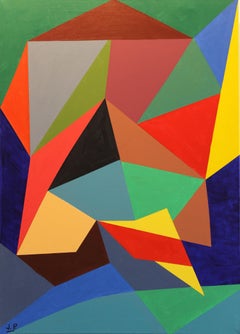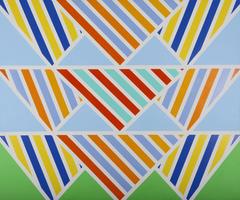Items Similar to Tectonic Tension / - Archetypes of Painting -
Want more images or videos?
Request additional images or videos from the seller
1 of 9
Jürgen MöbiusTectonic Tension / - Archetypes of Painting -1981
1981
$1,339.60
$1,674.5020% Off
£996.37
£1,245.4720% Off
€1,120
€1,40020% Off
CA$1,870.92
CA$2,338.6520% Off
A$2,030.41
A$2,538.0120% Off
CHF 1,068.31
CHF 1,335.3920% Off
MX$24,669.51
MX$30,836.8920% Off
NOK 13,375.08
NOK 16,718.8520% Off
SEK 12,593.86
SEK 15,742.3220% Off
DKK 8,529.79
DKK 10,662.2320% Off
About the Item
Jürgen Möbius (*1939 Großenhain), Tectonic Tension. Oil on hardboard, 47.5 x 60 cm, 49 x 61.5 cm (frame), signed lower right "Möbius" and dated "[19]81".
- Upper left corner with a small chip, light scratches and a little rubbed in places. Provisional gallery frame with traces of use.
- Archetypes of Painting -
About the artwork
The form structure in front of the eye is overlapped by the frame. Thus, the frame does not open up a space in which something is presented, but rather shows the seemingly arbitrary section of a comprehensive context that cannot be framed as such.
We see forms that stand in a structure of tension with each other, whereby the individual black and brown forms, which continue almost endlessly beyond the frame, already show a tension in themselves, since they are not only forms, but also surfaces - form surfaces, while the light blue surface ground is at the same time forms that appear as surface forms. The formed surfaces and surface forms are nested within each other and form a structure that encompasses all elements.
The angular arrangement of the black and brown shaped surfaces gives the structure a tectonic character. The tension is thus heightened to the point of paradox, since the black shape at the front is overlapped by the brown shape at the bottom in the center of the picture, which would be impossible in real space. It is precisely through this "paradox" that Möbius demonstrates that the paradoxical is reality within painting. It is, so to speak, the most original possibility of painting, which distinguishes it from the other arts. In combination with the tectonic formations, Jürgen Möbius creates an archaic primordial painting, which, however, should not be confused with the autonomous color and form cosmos of Suprematism à la Kasimir Malevich. Instead of homogeneous, perfectly colored forms, here the colors are deliberately applied unevenly, and the light blue is mixed with the brown in a manner determined by the brushstroke. At the edges of the surface forms, the uneven application of paint allows the wood of the unprimed hardboard to show through. In this way, Möbius illustrates that we are dealing with a painting that has been created by an act of painting - an act, however, that takes hold of the original principles of painting and thus realizes painting as such.
About the artist
From 1959 to 1965 Jürgen Möbius studied painting at the University Institute for Art and Work Education in Mainz. He also studied philosophy and art history at the University of Mainz. Afterwards he worked as a freelance artist in Mainz.
At first, Möbius created material reliefs and installations, then, around 1974, he turned increasingly to conceptual art and added cinematic means. During this phase he wrote the manifesto-like essay "Principles of Supranatural Landscape" (1979).
From 1981 on, Möbius concentrated on painting and searched for artistic ways to "treat intellectual and sensual perception equally in the fusion of representational and abstract pictorial elements" (Wolfgang Zemter). He found inspiration on his study trips to Thailand and Sri Lanka.
"The pure painting of Jürgen Möbius flows through us as a timeless expression of memory and energy, ploughing our perception and bringing us the happiness of seeing authentic, immovable form.
- Philippe Büttner
Selection of solo exhibitions
1969 Galerie Würzner, Düsseldorf / Galerie Gurlitt, Mainz
1972 Städtische Galerie, Mainz
1973 Galerie Schloss Ringenberg Rathaus, Kleve
1974 Röderhausmuseum, Wuppertal
1976 Galerie Glasing, Osnabrück / Städtische Galerie, Herne
1977, 1997, 2004 Märkisches Museum, Witten
1979 Studio M, Bamberg / Staatstheater, Darmstadt
1980 Galerie Stolànovà, Wiesbaden / Mittelrheinmuseum, Koblenz
1982 Galerie Dornhöfer, Mainz
1984 Galerie Neumühle, Schlangenbad
1985 Landesmuseum, Mainz / Kunstverein, Ludwigshafen / Nassauischer Kunstverein, Wiesbaden
1986 Museum, Bochum / Galerie der Stadt Iserlohn
1987, 1990 Galerie Klaus Kiefer, Essen
1987, 2000 Galerie Ulrike Buschlinger, Wiesbaden
1988 Kunsthalle Darmstadt
1988, 1992, 1996, 1999 Galerie Leonhard, Basel
1992, 2002 Galerie Zulauf, Freisheim
1994 Galerie Remy, Vallendar
1995 Sendezentrum des Zweiten Deutschen Fernsehens, Mainz
2001 Collegium oecumenicum, Bamberg / MVB Forum für Kultur und Wirtschaft, Mainz
2006 Adam Gallery, London
Selection of group exhibitions
1969 ‘International Graphic Arts’, Galerie Dalléas Bordeaux, Paris
1975 ‘Deutscher Künstler-Bund’, Dortmund
1979 ‘Man and man’s Images’, Märkisches Museum Witten
1980 ‘Love-Dokuments of our Time’, Art Hall Darmstadt and Art Association Hannover
1982 ‘Work - Progress – Position’, Nassau Art Association Wiesbaden
1983 ‘Principle Hope – Utopic Aspects in Art and Culture of the 20th Century’, Museum Bochum
1986 ‘Selfportraits’, Gallery Klaus Kiefer Essen
1987 ‘The Dying and Death’, Gallery Klaus Kiefer Essen
1989 ‘Where are You, Revolution – Freedom, Liberty, Egality, Fraternity to-day’, Museum Bochum 1990 ‘Flight – a Problem within the Memory of Man’, Kunsthalle Darmstadt ‘Art and War 1939 – 89’, House of Cultures Berlin
1991 ‘Material and Form’, Pillnitz Castle Dresden and Pfalz Gallery Kaiserslautern
1995 20 Years Exhibitions, Chrämerhuus Langenthal, Schweiz
1998 ‘Works on Paper’, Klaus Kiefer Gallery Essen
2000 ‘Acquisitions 1900 – 2000’, Mittelrhein-Museum Koblenz
2001 ‘Strange Pictures’, Klaus Kiefer Gallery Essen
2002 ‘10 Years Buschlinger Gallery’, Buschlinger Gallery Wiesbaden
2004 ‘Eternal Space – Pictures and Sculptures’, Dome of Bamberg
2005 Art Fair Chicago, Adam Gallery, London
Selected Bibliography
Mittelrheinisches Landesmuseum (Hrsg.): Jürgen Möbius - Neue Bilder, Mainz 1985.
Kunstverein Darmstadt (Hrsg.): Jürgen Möbius. Bilder 1985 - 1988. Kunsthalle Darmstadt, 26. Juni - 14. August 1988. Red. Dorit Marhenke, Lyrik Marcus Schiltenwolf, Düsseldorf 1988.
Gabriele Prusko (Hrsg.): Jürgen Möbius. Mit Texten von Philippe Büttner und Ralph Mieritz, Basel 1992.
Wolfgang Zemter (Hrsg.): Jürgen Möbius - Aktuelle Arbeiten. Märkisches Museum der Stadt Witten, Bönen 1999.
Wolfgang Zemter (Hrsg.): Jürgen Möbius. Flieger in meinem Zimmer und Beruhigte Zone, Bönen 2004.
Dama Gallery (Hrsg.): Jürgen Möbius, London 2014.
GERMAN VERSION
Jürgen Möbius (*1939 Großenhain), Tektonische Spannung. Öl auf Hartfaser, 47,5 x 60 cm, 49 x 61,5 cm (Rahmen), unten rechts mit „Möbius“ signiert und auf „[19]81“ datiert.
- Obere linke Ecke mit kleinem Ausbruch, leichte Kratzspuren und stellenweise etwas berieben. Provisorischer Galerierahmen mit Gebrauchsspuren.
- Urformen der Malerei -
zum Kunstwerk
Das vor Augen stehende Formgefüge wird vom Bildrahmen überschnitten. Damit eröffnet der Rahmen nicht einen Raum, innerhalb dessen sich etwas präsentiert, vielmehr zeigt er den scheinbar willkürlichen Ausschnitt eines umfassenden Zusammenhangs, der sich als solcher gar nicht einrahmen lässt.
Wir sehen Formen, die in einem Spannungsgefüge zueinanderstehen, wobei die einzelnen, sich schier endlos über den Bildrahmen hinaus fortsetzenden schwarzen und braunen Formen bereits in sich eine Spannung aufweisen, da sie nicht einzig Formen, sondern zugleich auch Flächen sind – Formflächen, während der hellblaue Flächengrund zugleich Formen ausbildet, die als Flächenformen in Erscheinung treten. Die Formflächen und Flächenformen sind ineinander verschachtelt und bilden ein alle Elemente einbeziehendes Gefüge aus.
Durch die winkelförmige Anordnung der schwarzen und braunen Formflächen weist das Gefüge einen tektonischen Charakter auf. Daher wird die Spannung geradewegs ins Paradoxale gesteigert, indem die vorn präsente schwarze Flächenform im Bildzentrum von der darunter liegenden braunen Flächenform überschnitten wird, was im realen Raum unmöglich wäre. Gerade anhand dieses ‚Paradoxons‘ führt Möbius vor Augen, dass das Paradoxale innerhalb der Malerei Wirklichkeit ist. Es ist gleichsam die ureigenste Möglichkeit der Malerei, welche die Malerei von den anderen Künsten unterscheidet. Im Verbund mit der ebenfalls ursprünglich wirkenden tektonischen Ausformung schafft Jürgen Möbius eine archaische Urmalerei, die allerdings nicht mit dem autonomen Farb- und Formenkosmos des Suprematismus à la Kasimir Malewitsch zu verwechseln ist. Statt farblich homogener in sich perfekter Formen sind die Farben hier bewusst ungleichmäßig aufgetragen und an das Braun auf eine vom Pinselduktus bestimmte Weise das helle Blau hineingemischt worden. An den Rändern der Flächenformen scheint gerade aufgrund des unregelmäßigen Farbauftrags sogar das Holz der nicht grundierten Hartfaserplatte durch. Auf diese Weise veranschaulicht Möbius, dass es sich um Malerei handelt, die eben durch einen Akt des Malens geschaffen worden ist – einen Akt allerdings, der die Urprinzipien der Malerei ergreift und damit die Malerei als solche realisiert.
zum Künstler
Von 1959 bis 1965 studierte Jürgen Möbius Malerei am Mainzer Hochschulinstitut für Kunst- und Werkerziehung. Zudem absolvierte er ein Studium der Philosophie und Kunstgeschichte an der Universität Mainz. Anschließend war er in Mainz als freischaffender Künstler tätig.
Zunächst schuf Möbius Materialreliefs und Installationen, um sich dann, gegen 1974, verstärkt der Konzeptkunst zuzuwenden und filmische Mittel hinzuzuziehen. In dieser Phase verfasste er den manifestartigen Essay „Prinzipien der supranaturalen Landschaft" (1979).
Ab 1981 konzentriert sich Möbius auf die Malerei und sucht nach künstlerischen Wegen, in der „Verschmelzung von gegenständlichen und abstrakten Bildelementen, die intellektuelle und sinnliche Wahrnehmung als gleichwertig [zu] behandeln“ (Wolfgang Zemter). Inspirationen dazu gewinnt er auf seinen Studienreisen, die nach Thailand und Sri Lanka führen.
„[Die reine Malerei von Jürgen Möbius] flutet als zeitloser Ausdruck von Erinnerung und Energie durch uns hindurch, pflügt unsere Wahrnehmung und bringt uns das Glück des Sehens authentischer, unverrückbarer Form.“
- Philippe Büttner
Auswahl an Einzelausstellungen
1969 Galerie Würzner, Düsseldorf / Galerie Gurlitt, Mainz
1972 Städtische Galerie, Mainz
1973 Galerie Schloss Ringenberg Rathaus, Kleve
1974 Röderhausmuseum, Wuppertal
1976 Galerie Glasing, Osnabrück / Städtische Galerie, Herne
1977, 1997, 2004 Märkisches Museum, Witten
1979 Studio M, Bamberg / Staatstheater, Darmstadt
1980 Galerie Stolànovà, Wiesbaden / Mittelrheinmuseum, Koblenz
1982 Galerie Dornhöfer, Mainz
1984 Galerie Neumühle, Schlangenbad
1985 Landesmuseum, Mainz / Kunstverein, Ludwigshafen / Nassauischer Kunstverein, Wiesbaden
1986 Museum, Bochum / Galerie der Stadt Iserlohn
1987, 1990 Galerie Klaus Kiefer, Essen
1987, 2000 Galerie Ulrike Buschlinger, Wiesbaden
1988 Kunsthalle Darmstadt
1988, 1992, 1996, 1999 Galerie Leonhard, Basel
1992, 2002 Galerie Zulauf, Freisheim
1994 Galerie Remy, Vallendar
1995 Sendezentrum des Zweiten Deutschen Fernsehens, Mainz
2001 Collegium oecumenicum, Bamberg / MVB Forum für Kultur und Wirtschaft, Mainz
2006 Adam Gallery, London
Auswahl an Gruppenausstellungen
1969 ‘International Graphic Arts’, Galerie Dalléas Bordeaux, Paris
1975 ‘Deutscher Künstler-Bund’, Dortmund
1979 ‘Man and man’s Images’, Märkisches Museum Witten
1980 ‘Love-Dokuments of our Time’, Art Hall Darmstadt and Art Association Hannover
1982 ‘Work - Progress – Position’, Nassau Art Association Wiesbaden
1983 ‘Principle Hope – Utopic Aspects in Art and Culture of the 20th Century’, Museum Bochum
1986 ‘Selfportraits’, Gallery Klaus Kiefer Essen
1987 ‘The Dying and Death’, Gallery Klaus Kiefer Essen
1989 ‘Where are You, Revolution – Freedom, Liberty, Egality, Fraternity to-day’, Museum Bochum 1990 ‘Flight – a Problem within the Memory of Man’, Kunsthalle Darmstadt ‘Art and War 1939 – 89’, House of Cultures Berlin
1991 ‘Material and Form’, Pillnitz Castle Dresden and Pfalz Gallery Kaiserslautern
1995 20 Years Exhibitions, Chrämerhuus Langenthal, Schweiz
1998 ‘Works on Paper’, Klaus Kiefer Gallery Essen
2000 ‘Acquisitions 1900 – 2000’, Mittelrhein-Museum Koblenz
2001 ‘Strange Pictures’, Klaus Kiefer Gallery Essen
2002 ‘10 Years Buschlinger Gallery’, Buschlinger Gallery Wiesbaden
2004 ‘Eternal Space – Pictures and Sculptures’, Dome of Bamberg
2005 Art Fair Chicago, Adam Gallery, London
Auswahlbibliographie
Mittelrheinisches Landesmuseum (Hrsg.): Jürgen Möbius - Neue Bilder, Mainz 1985.
Kunstverein Darmstadt (Hrsg.): Jürgen Möbius. Bilder 1985 - 1988. Kunsthalle Darmstadt, 26. Juni - 14. August 1988. Red. Dorit Marhenke, Lyrik Marcus Schiltenwolf, Düsseldorf 1988.
Gabriele Prusko (Hrsg.): Jürgen Möbius. Mit Texten von Philippe Büttner und Ralph Mieritz, Basel 1992.
Wolfgang Zemter (Hrsg.): Jürgen Möbius - Aktuelle Arbeiten. Märkisches Museum der Stadt Witten, Bönen 1999.
Wolfgang Zemter (Hrsg.): Jürgen Möbius. Flieger in meinem Zimmer und Beruhigte Zone, Bönen 2004.
Dama Gallery (Hrsg.): Jürgen Möbius, London 2014.
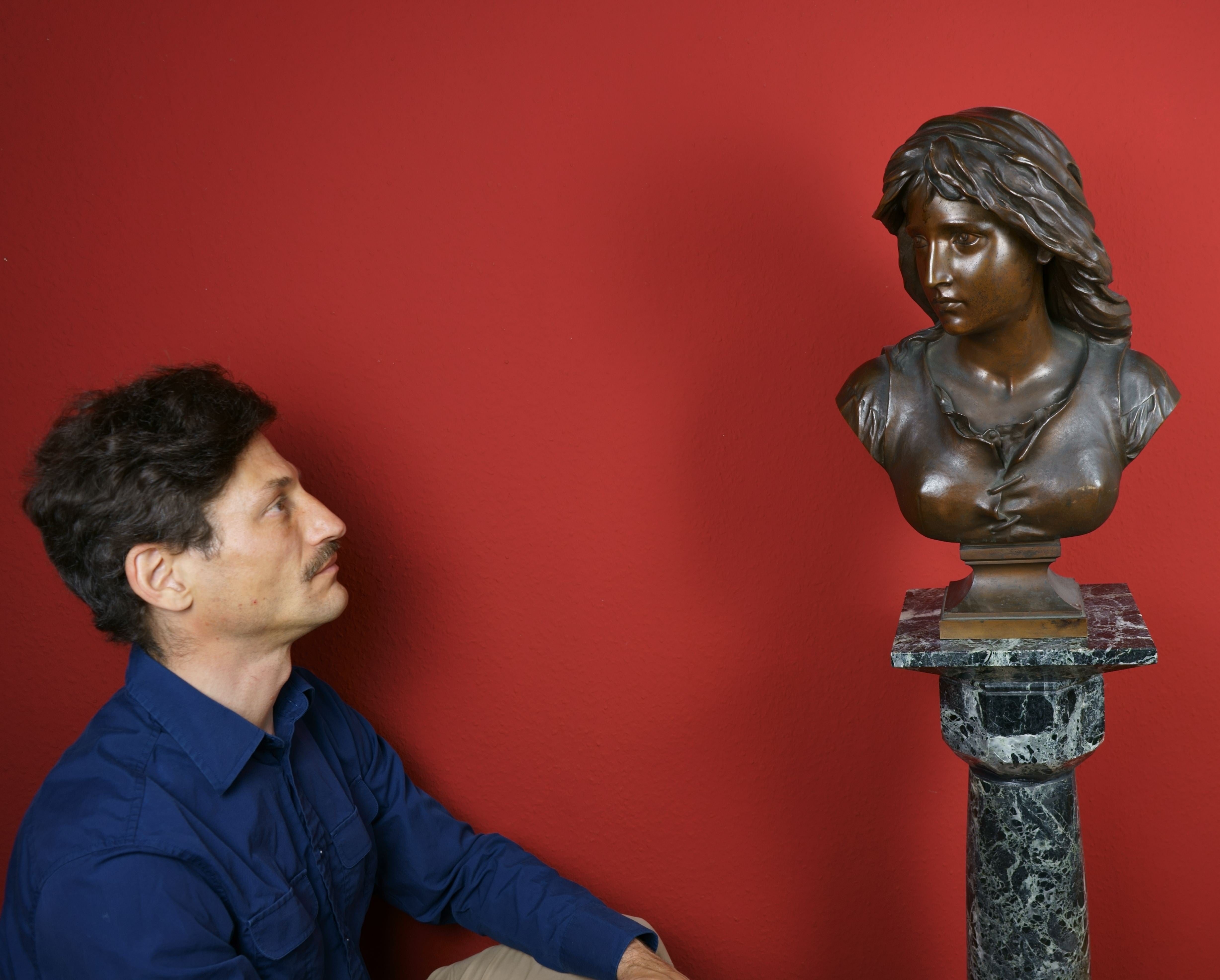
About the Seller
5.0
Vetted Professional Seller
Every seller passes strict standards for authenticity and reliability
Established in 2014
1stDibs seller since 2023
21 sales on 1stDibs
- ShippingRetrieving quote...Shipping from: Berlin, Germany
- Return Policy
Authenticity Guarantee
In the unlikely event there’s an issue with an item’s authenticity, contact us within 1 year for a full refund. DetailsMoney-Back Guarantee
If your item is not as described, is damaged in transit, or does not arrive, contact us within 7 days for a full refund. Details24-Hour Cancellation
You have a 24-hour grace period in which to reconsider your purchase, with no questions asked.Vetted Professional Sellers
Our world-class sellers must adhere to strict standards for service and quality, maintaining the integrity of our listings.Price-Match Guarantee
If you find that a seller listed the same item for a lower price elsewhere, we’ll match it.Trusted Global Delivery
Our best-in-class carrier network provides specialized shipping options worldwide, including custom delivery.More From This Seller
View AllBlack form surfaces on red painterly ground / - The Double Origin of Painting -
Located in Berlin, DE
Jürgen Möbius (*1939 Großenhain), Black form surfaces on red painterly ground. Oil on hardboard, 50 x 60 cm, 51 x 61 cm (frame), signed "Möbius" and dated "[19]81".
- Small paint chip in upper right corner, otherwise good condition. Gallery frame with slight signs of wear.
- The Double Origin of Painting -
About the artwork
In the painting black, optically dominant forms can be seen, which in their arrangement at right angles to each other have a proto-architectural character. They are, so to speak, always already given original forms. At the same time, however, the forms are surfaces of color, and thus genuine painting. In order to make the painterly character of the painting clearly visible, Jürgen Möbius has applied red-toned strokes that have preserved the brushstroke. These are traces of an act of painting.
The diagonal layers of red strokes merge into the upper white area, which oscillates between brushwork and homogeneous flatness, while the central white field, into which a black bar protrudes, has a decidedly planar character.
The sharp contrast between the autonomous black surface forms, reminiscent of Kasimir Malevich, and the free brushstroke, which is not bound to any motif, creates an enormous pictorial tension, which is conveyed by the white, but at the same time is intensified by the virulent black-and-white contrast.
In addition to the tense contrast of form and color, there is also a contrast between the dynamic of the brushstroke and the static of the black surface forms, whereby the diagonal alignment of these forms also gives the static a dynamic, while at the same time the layered brushstrokes have something static about them.
Added to this structure of tension is the fact that the painting ground, the unprepared hardboard, is clearly present as such in the picture. In this way, it becomes clear once again that we are not dealing with an autonomous cosmos of form and color, as in Suprematism, but with a painting created by the artist's hand.
With this work, Jürgen Möbius explores the possibilities of painting and thematizes painting in terms of its twofold origin, the trace of the guided brush and the painterly form, which gains its independence precisely by absorbing the brushstroke into itself.
About the artist
From 1959 to 1965 Jürgen Möbius studied painting at the University Institute for Art and Work Education in Mainz. He also studied philosophy and art history at the University of Mainz. Afterwards he worked as a freelance artist in Mainz.
At first, Möbius created material reliefs and installations, then, around 1974, he turned increasingly to conceptual art and added cinematic means. During this phase he wrote the manifesto-like essay "Principles of Supranatural Landscape" (1979).
From 1981 on, Möbius concentrated on painting and searched for artistic ways to "treat intellectual and sensual perception equally in the fusion of representational and abstract pictorial elements" (Wolfgang Zemter). He found inspiration on his study trips to Thailand and Sri Lanka.
"The pure painting of Jürgen Möbius flows through us as a timeless expression of memory and energy, ploughing our perception and bringing us the happiness of seeing authentic, immovable form.
- Philippe Büttner
Selection of solo exhibitions
1969 Galerie Würzner, Düsseldorf / Galerie Gurlitt, Mainz
1972 Städtische Galerie, Mainz
1973 Galerie Schloss Ringenberg Rathaus, Kleve
1974 Röderhausmuseum, Wuppertal
1976 Galerie Glasing, Osnabrück / Städtische Galerie, Herne
1977, 1997, 2004 Märkisches Museum, Witten
1979 Studio M, Bamberg / Staatstheater, Darmstadt
1980 Galerie Stolànovà, Wiesbaden / Mittelrheinmuseum, Koblenz
1982 Galerie Dornhöfer, Mainz
1984 Galerie Neumühle, Schlangenbad
1985 Landesmuseum, Mainz / Kunstverein, Ludwigshafen / Nassauischer Kunstverein, Wiesbaden
1986 Museum, Bochum / Galerie der Stadt Iserlohn
1987, 1990 Galerie Klaus Kiefer, Essen
1987, 2000 Galerie Ulrike Buschlinger, Wiesbaden
1988 Kunsthalle Darmstadt
1988, 1992, 1996, 1999 Galerie Leonhard, Basel
1992, 2002 Galerie Zulauf, Freisheim
1994 Galerie Remy, Vallendar
1995 Sendezentrum des Zweiten Deutschen Fernsehens, Mainz
2001 Collegium oecumenicum, Bamberg / MVB Forum für Kultur und Wirtschaft, Mainz
2006 Adam Gallery, London
Selection of group exhibitions
1969 ‘International Graphic Arts’, Galerie Dalléas Bordeaux, Paris
1975 ‘Deutscher Künstler-Bund’, Dortmund
1979 ‘Man and man’s Images’, Märkisches Museum Witten
1980 ‘Love-Dokuments of our Time’, Art Hall Darmstadt and Art Association Hannover
1982 ‘Work - Progress – Position’, Nassau Art Association Wiesbaden
1983 ‘Principle Hope – Utopic Aspects in Art and Culture of the 20th Century’, Museum Bochum
1986 ‘Selfportraits’, Gallery Klaus Kiefer Essen
1987 ‘The Dying and Death’, Gallery Klaus Kiefer Essen
1989 ‘Where are You, Revolution – Freedom, Liberty, Egality, Fraternity to-day’, Museum Bochum 1990 ‘Flight – a Problem within the Memory of Man’, Kunsthalle Darmstadt ‘Art and War 1939 – 89’, House of Cultures Berlin
1991 ‘Material and Form’, Pillnitz Castle Dresden and Pfalz Gallery Kaiserslautern
1995 20 Years Exhibitions, Chrämerhuus Langenthal, Schweiz
1998 ‘Works on Paper’, Klaus Kiefer Gallery Essen
2000 ‘Acquisitions 1900 – 2000’, Mittelrhein-Museum Koblenz
2001 ‘Strange Pictures’, Klaus Kiefer Gallery Essen
2002 ‘10 Years Buschlinger Gallery’, Buschlinger Gallery Wiesbaden
2004 ‘Eternal Space – Pictures and Sculptures’, Dome of Bamberg
2005 Art Fair Chicago, Adam Gallery, London
Selected Bibliography
Mittelrheinisches Landesmuseum (Hrsg.): Jürgen Möbius - Neue Bilder, Mainz 1985.
Kunstverein Darmstadt (Hrsg.): Jürgen Möbius. Bilder 1985 - 1988. Kunsthalle Darmstadt, 26. Juni - 14. August 1988. Red. Dorit Marhenke, Lyrik Marcus Schiltenwolf, Düsseldorf 1988.
Gabriele Prusko (Hrsg.): Jürgen Möbius. Mit Texten von Philippe Büttner und Ralph Mieritz, Basel 1992.
Wolfgang Zemter (Hrsg.): Jürgen Möbius - Aktuelle Arbeiten. Märkisches Museum der Stadt Witten, Bönen 1999.
Wolfgang Zemter (Hrsg.): Jürgen Möbius. Flieger in meinem Zimmer und Beruhigte Zone, Bönen 2004.
Dama Gallery...
Category
1980s Abstract Abstract Paintings
Materials
Oil
Rare Animal / - Abstract figuration -
Located in Berlin, DE
Veit Hofmann (*1944 Dresden), Rare Animal, 1987. Oil on light card, 42 cm (height) x 30 cm (width), monogrammed “V[eit]H[ofmann]” lower right and dated “[19]87”, titled “Seltenes Tie...
Category
1980s Abstract Expressionist Abstract Paintings
Materials
Oil
Untitled / - The archaism of nature -
Located in Berlin, DE
Jorge Machold (1940 Chemnitz - 2015 Berlin), Untitled, 1973. Color etching, 41.5 x 29.2 cm (plate size), 49.5 cm x 39.5 cm (sheet size), signed lower right in lead “J.[orge] Machold”...
Category
1970s Abstract Abstract Prints
Materials
Paper
Untitled / - Association -
Located in Berlin, DE
Detlef Baltrock (*1954 Stuttgart), Untitled, 1985. Watercolor, 29.5 cm x 21 cm (visible dimensions), 41 cm x 32 cm (frame), signed “Baltrock” lower center and signed “[19]85”, label ...
Category
1980s Abstract Expressionist Abstract Drawings and Watercolors
Materials
Paper
Field - Field research -
Located in Berlin, DE
Karl Ludwig Mordstein (1937 Füssen - 2006 Wilszhofen), Field 1983. Color etching, copy 13/65, 22.5 x 28 cm (image), 40 x 45 cm (sheet), 43 x 48 cm (frame), titled, numbered, monogram...
Category
1980s Abstract Abstract Prints
Materials
Etching
$430 Sale Price
20% Off
Threatening to defeat me once and for all / - A Christmas Pietà -
Located in Berlin, DE
Johannes Heisig (*1953 Leipzig), "Threatening to defeat me once and for all" - To the Christmas Oratorio by Johann Sebastian Bach. Lithograph on strong yellowish laid paper with wate...
Category
1980s Abstract Expressionist Figurative Prints
Materials
Lithograph
$363 Sale Price
20% Off
You May Also Like
French Contemporary Abstract Art by J.-L. Veret - Allégorie
By Jean-Luc Veret
Located in Paris, IDF
Acrylic on canvas
Jean-Luc Veret is a French artist born in 1953 who lives & works between Paris & Corancy, France. He recognizes himself as a protean artist. He is indeed graduated...
Category
2010s Abstract Abstract Paintings
Materials
Acrylic
PRISMAS, Painting, Acrylic on Canvas
Located in Yardley, PA
ACRYLIC PAINTING IN WOODEN FRAME, ON SUPPORT OF FABRIC. IS PROVIDED WITH A VARNISH LAYER TO SAVE FROM DUST AND DIRT :: Painting :: Abstract :: This piece comes with an official ce...
Category
2010s Abstract Abstract Paintings
Materials
Acrylic
Austrian Contemporary Art by Brigitte Thonhauser-Merk - Ciel et Terre
By Brigitte Thonhauser-Merk
Located in Paris, IDF
After decades of accelerated technical experimentation and refinement, decades of waiting to finally have access to academia to study Art History, and being mentored by renowned arti...
Category
Early 2000s Abstract Abstract Paintings
Materials
Acrylic, Canvas
Contest 2
By Charles Miesmer
Located in Fairfield, CT
Miesmer began painting in the open air during the summers in Nantucket. Using a pad of Arches paper as an easel and working out of the back of his pickup truck, the quietude and pea...
Category
21st Century and Contemporary Abstract Geometric Abstract Paintings
Materials
Acrylic, Canvas
Modern Abstract
Located in Houston, TX
Bold abstract painting by French artist, circa 1960.
Original artwork on paper displayed on a white mat with a gold border. Mat fits a standard-size frame. Archival plastic sleeve ...
Category
1960s Abstract Paintings
Materials
Acrylic
Abstract Modern Painting by Benjamin Benno
By Benjamin G. Benno
Located in Long Island City, NY
An original oil painting on canvas by Benjamin Benno, American (1901 - 1980) measuring 40 x 24 inches, unsigned. Provenance: O'Hara Gallery, NYC. By the early 1930's Benno had estab...
Category
Mid-20th Century Modern Abstract Paintings
Materials
Canvas, Oil
Price Upon Request
More Ways To Browse
Dior 1987
Sunflower Abstract
Abstract Sailboat
Airbrush Art
Architectural Blueprints
Large Horizontal Painting
Maroon Art
Paper Airplane
Psychedelic Painting
Sergei Chernyakovsky
Dia De Muertos
Galaxy Painting
Jack Shadbolt
Marfa Texas
Mexico San Miguel
Mid Century Modern Austin Texas
Oil Stick Painting
1950s Abstract Oil Paintings
